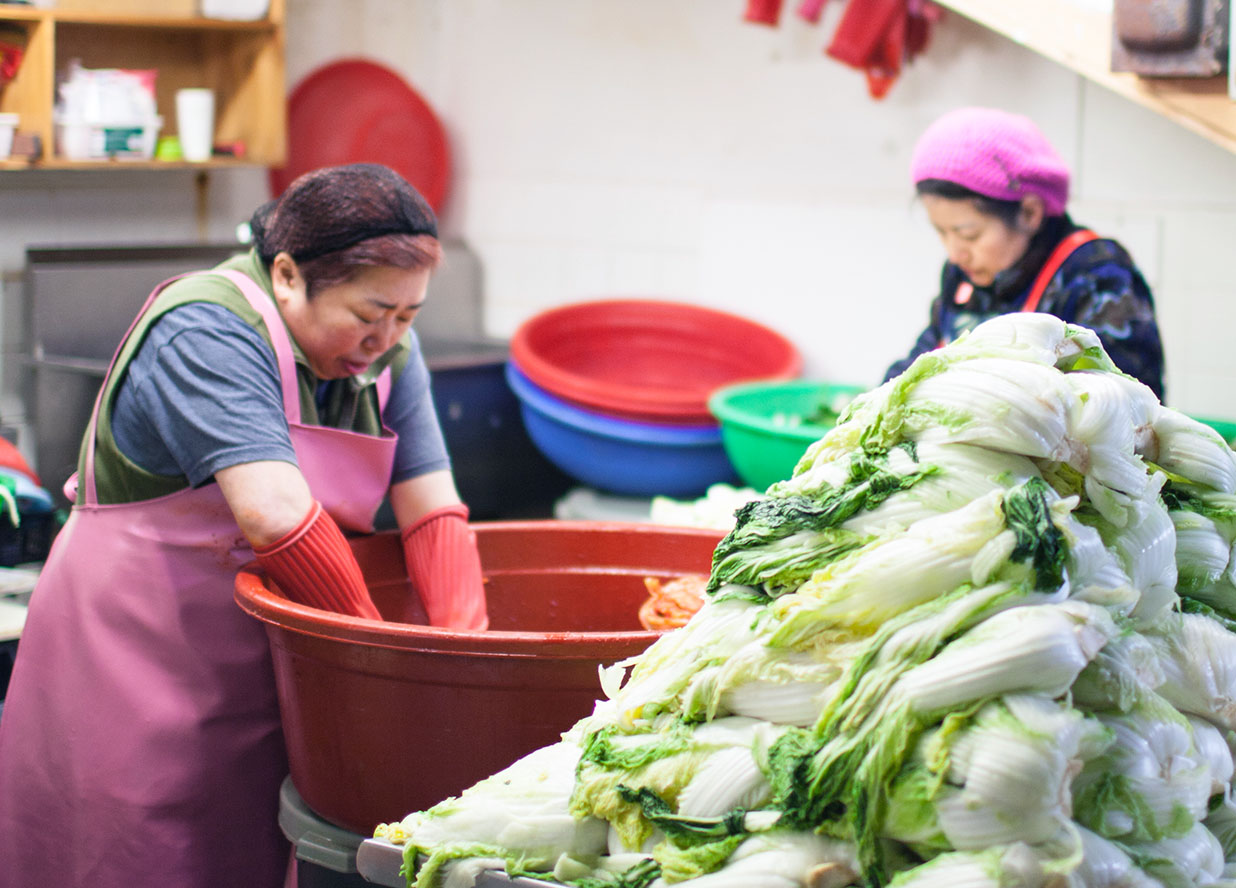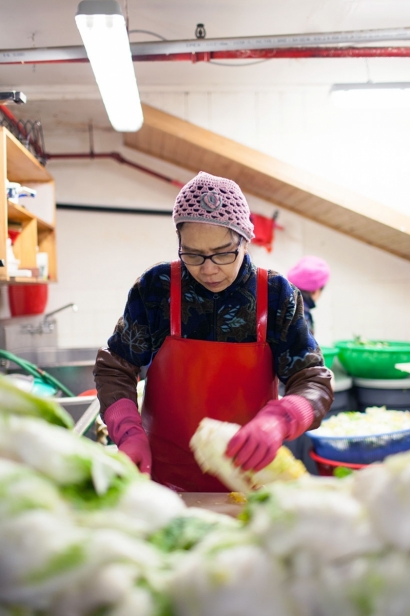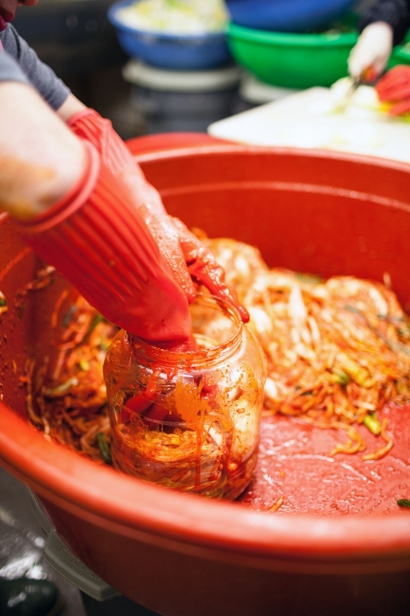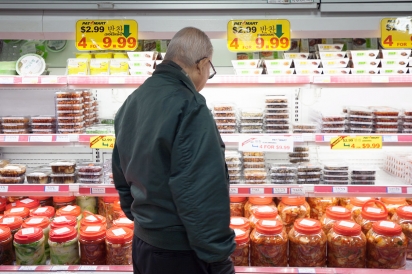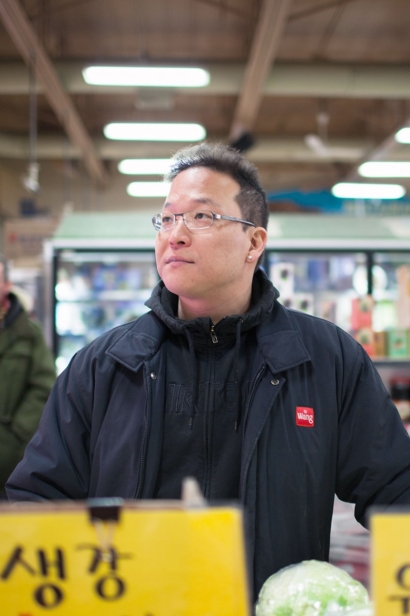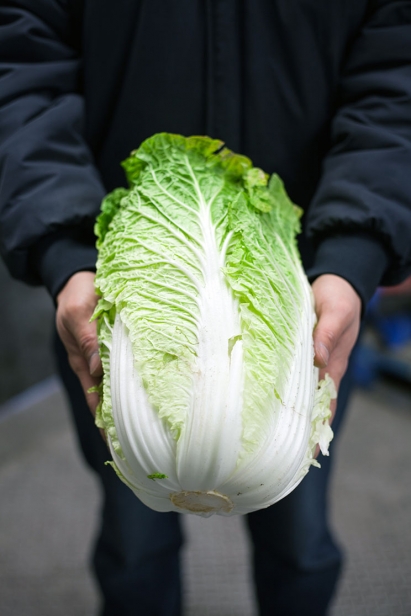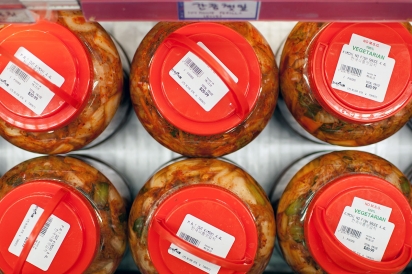A Kimchi Story
Kimchi is simple: Combine vegetables, salt and some flavour and allow the mixture to sit until it is pleasingly tangy and crunchy. Depending on your taste, that can mean mere hours or it could take months. For Edward Lee, kimchi is part of what helped his family thrive when they arrived in Canada nearly 50 years ago. It was a time when the few Korean-Canadians who lived in Toronto were yearning for tastes of home.
At P.A.T. (Pan Asia Trade) Central Market in Toronto’s Bloor Street Koreatown, you’ll find the kimchi at the back of the store on a refrigerated wall next to the rest of the banchan (side dishes). There is dry-seasoned squid, marinated tofu, brightgreen sesame spinach and salty peanuts studded with dried fish. Kimchi, however, has a special place in Korean cooking, far more important than the term “side dish” implies.
When Lee was a boy, he found kimchi to be too spicy. “I would dip it in water to wash off some of the heat,” he remembers.
As in any Korean home it was a near-daily staple, so Lee, who now manages his family’s store, eventually learned to eat it without rinsing off the gochugaru, the Korean chili powder commonly used in kimchi.
To say that kimchi lives in every Korean’s home is not an exaggeration and it can be taken literally. Kimchi is a living entity, a vegetable fermented with a family of bacteria that forms its character over time. It is fresh, lively and crunchy early in its life, ideal for eating cold. It becomes complex and effervescent as it ages. In a typical refrigerator, says Lee, it takes three or four weeks for a sour profile to emerge and a softer crunch develops. “That’s when it’s perfect for cooking with,” Lee explains.
Kimchi is commonly made of Napa cabbage and radish, but the combinations are endless. There is oi sobagi (cucumber) kimchi, gat (mustard leaf) kimchi and baek (white cabbage without the chili) kimchi, to name a few. Fish sauce or fermented shrimp are often used, as are ginger, garlic, chives and green onions.
What can be made into kimchi is up to the imagination. Some cooks will include fruit or unlikely vegetables such as asparagus or rutabaga, but there are common denominators. Kimchi should be salty, tangy, cool and crunchy.
While the sky's the limit with kimchi, its origins come from necessity. Fermentation has a long history in Korean cooking where preservation of vegetables through cold winter months was crucial to survival. Early versions of kimchi were closer to something like sauerkraut; not much more than cabbage and salt. Kimchi as we know it today was only possible in the early 17th century, when chili peppers made their way from the Americas to Korea, brought by invading Japanese forces.
Today, Lee’s grocery store is at the heart of the city’s Koreatown. The house-made kimchi is so popular, the store goes through a minimum of 20 cases of Napa cabbage every week, much of which is supplied by farms, such Yu An Farms, in Southern Ontario during the growing season and imported during the winter. For those who like it spicy, there’s plenty with gochugaru. For those who don’t, baek kimchi is also on offer.
P.A.T. Central Market is a large, sprawling supermarket. It is always busy, the tight aisles buzzing with customers, both Korean- Canadian and non-Korean.
Despite its massive success the store has a humble family story.
Back in the early 1970s, Lee’s grandmother, Sun Ok Lee, was a central character in the burgeoning Korean community in Toronto. She was one of the few women who had immigrated from South Korea at a time when most expats were young male students. Korean food products were hard to come by, and the young men missed the taste of home, Lee explains.
“These guys didn’t know how to cook so they couldn’t have Korean food,” Lee says. So, when Sun Ok Lee would pack lunches for Lee’s father and uncles, “she’d pack up a little extra for those guys. They were living on the other side of the world. They didn’t speak much English.” In short, they were homesick and Sun Ok Lee’s cooking reminded them of home.
As the Korean community grew, feeding her sons’ friends got expensive and it became clear to the Lee family there was now a market for Korean groceries in Toronto.
A business was born.
The family began operating a small Korean grocery store on Palmerston Avenue. It was a corner store, barely big enough to turn around.
“I grew up playing on the rice, helping my parents whenever they asked me. I’d carry bags out for customers here and there.” There was a park across the street and Lee would play until dark when his mother would yell out the door to come in for bed. He has happy memories, but also acknowledges his parents worked tremendously hard.
“Every Sunday after church, we’d get a huge influx of Korean families… it was 700 square feet,” he quips.
Things were physically tight, but for three decades, the Lee family business grew into the Koreatown staple it is today.
In 2004, the Lees moved from the postage-stamp-sized Palmerston store to the Bloor Street location. With a footprint 10 times bigger, the shelves are stocked high. Even though PAT could have a big-box-store vibe, it doesn’t.
Like his father before him, Lee gets to know his customers, answers their questions. He is approachable and friendly. So is the staff. The familial vibe of this large, successful store is still in the air. There are three other locations of PAT across the GTA, each run by a different member of the extended Lee family.
Lee’s father would often visit with his very first customers after they had moved to retirement homes. “He feels that if it weren’t for those customers, he wouldn’t have been able to buy a house, send his kids to college.”
Part of the exploding success of the store is due to the influx of Korean immigrants to Toronto, around the time the store first opened.
Lee remembers a time when your average non-Korean was suspicious of the jar of slightly funky, fermenting cabbage at the back of the fridge. Health inspectors were not immune to this kind of suspicion. Lee’s father had a bit of fun with one particularly skeptical inspector who raised his eyebrows at the unfamiliar pickle back in the 1980s.
“My dad reached for a jar of kimchi that had been forgotten at the back of a shelf. It was so old that he had to peel a layer of fungus off the top. He said: ‘I have full confidence this is going to come back safe,’” Lee remembers.
When the health inspector came back, a few weeks later, he dropped a thick folder on the counter. “He couldn’t believe it. He said ‘I’ve never seen anything like this in my life… It gets healthier as it grows older.”
Kimchi no longer raises as many eyebrows in Toronto. Even non-Korean local food purveyors are producing it.
“Fermentation develops unique, complex flavours and kimchi has the most,” says Rebekka Hutton, owner of Alchemy Pickle Company, who produces “regional and seasonal vegan kimchi.”
“More interest in the health benefits and the flavours of ferments has likely contributed to [kimchi’s] wider popularity,” she explains.
Lee has advice for those who have yet to try kimchi. Trust the friends who know best. “My suggestion is to eat dinner at a Korean friend's house, every Korean will say their mom or grandma makes the best kimchi,” says Lee.
So, what if you have no Korean friends? Then consider yourself a friend of Lee’s and sample the stuff at the back of P.A.T. Central Market.
P.A.T. Central Market
675 Bloor St. W., Toronto, Ont.
patmart.ca | 416.532.2961


